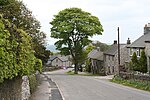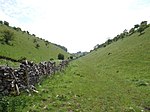Fin Cop

Fin Cop is a hill and an associated Iron Age hill fort in Monsal Dale, close to Ashford in the Water in Derbyshire, England.The fort shows evidence of hurried construction, indicating a defensive response to a real threat, rather than the more usual assumption that such forts were a display of status and prestige. The hillfort, along with an adjacent bowl barrow, lime kiln and quarry, constitutes a Scheduled Ancient Monument. In 2011 excavations unearthed a mass burial containing only women and children, the first such segregated burial in Iron Age Britain. Some animal bones were also found, suggesting the inhabitants kept livestock. The remains were relatively well preserved due to the limestone geology of the hill. Carbon dating of the site suggests it was constructed between 440BC and 390BC.
Excerpt from the Wikipedia article Fin Cop (License: CC BY-SA 3.0, Authors, Images).Fin Cop
Brushfield Lane, Derbyshire Dales
Geographical coordinates (GPS) Address Nearby Places Show on map
Geographical coordinates (GPS)
| Latitude | Longitude |
|---|---|
| N 53.235833333333 ° | E -1.7369444444444 ° |
Address
Brushfield Lane
SK17 8SZ Derbyshire Dales
England, United Kingdom
Open on Google Maps









